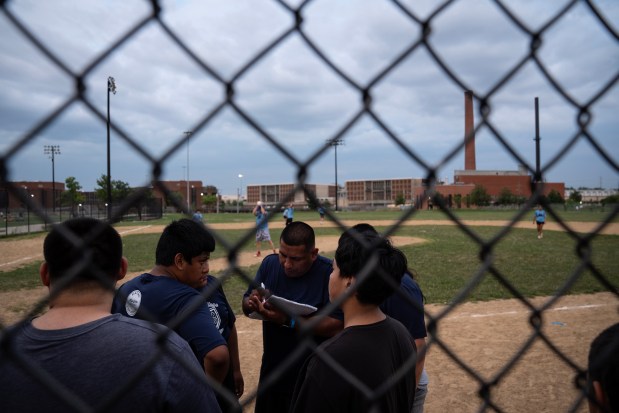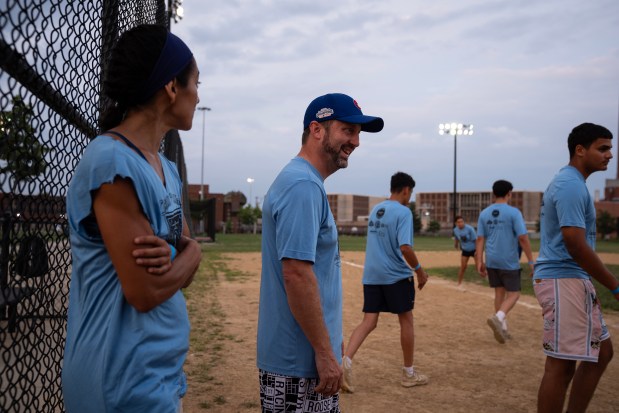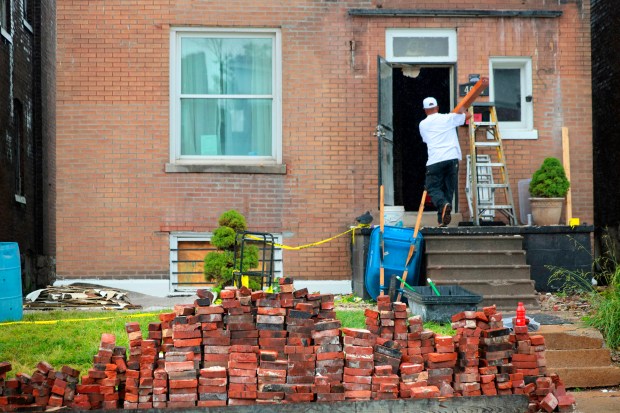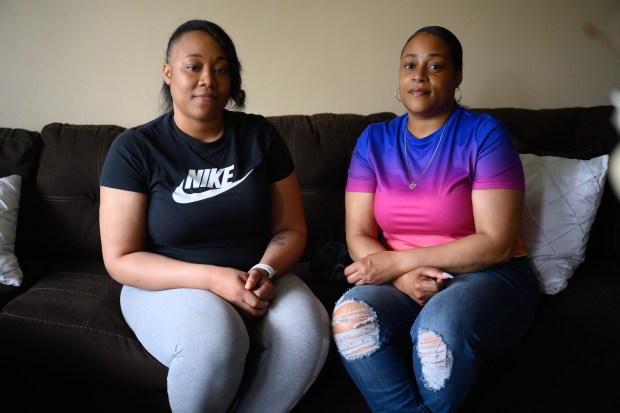Every Thursday, as the sun begins to go down and the summer days cool off, men and women come together to play softball at La Villita Park in Chicago’s South Lawndale community.
Many have a history of being involved in gangs, but on these nights, they trade those traditional colors for jerseys and play in teams as part of a yearslong program that aims to reduce violence in the neighborhood.
On a recent afternoon, a little boy stood on his tiptoes to pick out an ice cream pop from a cart while families lined up for plates of food and bags of chicharrones, or fried pork rinds. People cheered while watching two games of softball underway on the park’s diamonds, the figures of inmates at Cook County Jail just visible across Sacramento Avenue.
Some of the players are “peacemakers” at night in the area’s hottest gang spots, mediating conflict. They’re men and women close to the lifestyle who understand it but also hope to make a change in their neighborhood.
Their work, however, comes with risk.
This summer, five men working as peacekeepers have been shot in Little Village and North Lawndale, likely in connection with the latest spasm of conflict between street gangs that have feuded in the West Side area for decades, outreach workers said. Three have died. All worked with New Life Centers, the Little Village-based nonprofit that administers social services and community assistance to people around the West Side.
The recent deaths have rattled the community, the organization and the people they work with, said Matt DeMateo, the CEO of New Life Centers. “Those who have died are our neighbors, our family. We are hurting,” he said.
But despite the deaths, DeMateo and other violence prevention advocates and researchers are confident that the anti-violence model is a long-term solution to reduce violence not only in Little Village, but in the city as a whole.
“It is risky,” he said. “There’s risk in all of it. But we view this as a long game.”
The shootings came within weeks of a June 17 announcement that community violence intervention organizations, including New Life Centers, would receive hundreds of millions of dollars in funding from the city intended to make the strategy “a permanent feature for Chicago public safety.”
Street outreach has been a feature of public safety efforts in Chicago for years, but the funding was the latest boost to make the programs more permanent, wide-reaching and effective.
Advocates say that despite the dangers some of the street workers face, data and analysis show that violence decreased dramatically in some of Chicago’s most tumultuous neighborhoods since the Flatlining Violence Inspires Peace program, or FLIP, which hires peacemakers, was implemented about six years ago.
The recent spiral of violence, which tends to worsen on hot summer days, has discouraged some from participating as peacemakers, DeMateo said. But there’s also an understanding that gang culture has deep and complex roots in the community.
DeMateo and other anti-violence outreach workers use the field during their Thursday game to create safe space for peacemakers and at-risk youth to share their fears and help them cope with the anger or loss.
As the game ended, Luis Bahena, a street outreach worker with New Life, dispensed fist-bumps and hugs to boys who moved around the park in packs. Unlike peacekeepers, outreach workers must be completely detached from gang life.
“A lot of people in the neighborhood are hurting right now,” he said.
This year, Bahena said it’s felt like “deaths (were) happening more frequently and rapidly … there was more retaliation all over the neighborhood.”
“It made me worried,” he said. “Sometimes I wonder about my safety too. It definitely got me alert.”
He was concerned for the young people he works with, who are at a high risk of getting involved in gang life.
New Life Centers has provided financial assistance to families affected by deaths, DeMateo said. It also provides emotional support and access to mental health services to youths as a whole.
New Life has 64 peacekeepers who work from 4 p.m. to midnight in 12 hot spots, DeMateo said. And as of December 2023, there were 750 peacekeepers citywide, per the most recent program evaluation report from Northwestern University.

The FLIP program has roots in an outreach model that’s been in use for decades, said University of Illinois Chicago social work scholar Kathryn Bocanegra: “Hire a worker that’s kind of detached from the gang but … still influential, and have them work within the network to reduce violence.”
Bocanegra said the methods that anchor programs like FLIP further developed through the Little Village Gang Reduction Project in the 1990s and expanded through interventions like Ceasefire Chicago.
Public officials looked to them anew following spikes of firearm violence in 2016 and 2020. Chicago CRED began its FLIP program in 2018.
Despite the long history of these kinds of interventions, Bocanegra said it’s only more recently that the field as a whole has begun to ask itself how to use workers’ experiences and instincts while making sure that they are protected.
Whatever organizations do to reduce risk to their workers “will never stop 100% of the bullets,” she said.
“We cannot control community violence dynamics,” she said. “What is within the control of the professional field is how people are trained, and how people are supported, what we do with the workforce — there is a lot you can do there.”
DeMateo said that “being so close and still being involved, there’s advantages to it, but there’s high risks as well.”
Peacekeepers are close to gang life by design. State program information describes the ideal peacekeeper candidates as people “who exhibit risk factors for violence, have credibility and influence with local groups/gangs/cliques, and are viewed as trusted insiders who are native to hot spots and community.”
Those who work with the program receive job training, GED preparation and education in adjacent issues like financial literacy or “Know Your Rights” training. They receive a $100 stipend each day and are expected to work four days of the week.
Cedric Hawkins, the outreach, safety and strategy manager at Chicago CRED, an anti-gun violence organization that works in Roseland, Pullman and North Lawndale, said FLIP workers are effective because they can use their relationships to keep a lid on conflict in a particular area. When a FLIP worker dies, not only is a life taken, but their connections also evaporate.
“That puts us in a position where … we may have to hire multiple individuals because that individual probably was one of the people that can get more than one thing done for us,” he said. “It’s a big effect on us.”
That the work is dangerous is a given, Hawkins said. He doesn’t anticipate injury rates will improve, though he added that he didn’t expect it to worsen either.
“Anything can happen,” he said. “We know this. It may not be safe. But it’s effective.”
DeMateo of New Life Centers said sites where the peacekeepers are deployed have “seen huge drops” in shootings and homicides over the last four years when the program was implemented in Little Village and Brighton Park.
The Northwestern University report found that original group of 14 community areas where peacekeepers were deployed saw a 24% drop in shooting victimizations during the second half of 2023 — largely on par with a citywide decline in shootings.
For the 107 hot spots that had assigned peacekeepers during the same period, the shooting victimization rate dropped by 35%, according to the report.
Northwestern University sociologist Andrew Papachristos, who helped lead the evaluation, cautioned that there wasn’t enough data to make a causal connection between peacekeeper deployment and the drop in shootings.
“The question is ‘can we elongate the gaps between (violent) events because of the intervention?’” he said. “And that’s really where we’re heading, but it’s going to take time.”
DeMateo said the program’s impact should not be based only on the number of shootings and homicides. Many of the peacekeepers have intervened to prevent shootings, fights and other types of conflicts, he said.
Papachristos described the initiative as “part violence prevention program and part job training program.”
“FLIP is actually trying to engage people to show them ways out,” he said.
The most recent report on the program found that 115 people working as peacekeepers have moved into more formal violence prevention work since 2018.
DeMateo said many of their peacekeepers have left gang life and are now in school, pursuing a career, raising a family, or have become outreach workers for New Life.
But few tell their story because of their history in the neighborhood in combination with rebuilding their lives, he said.
“It’s not easy to leave that lifestyle,” DeMateo said. “These are resilient people that should be given more credit, empathy and respect for their work in the neighborhood.”
“We have way more success stories than we do tragedies. And I think that’s the thing we have to constantly remind ourselves, there’s so much hope,” he said. “There’s so much healing happening.”





